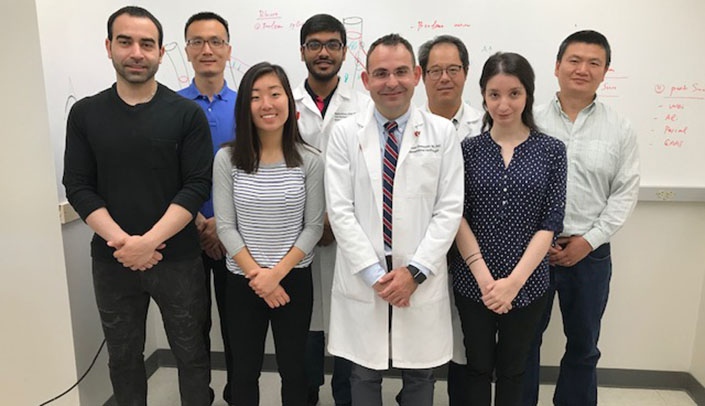A team of UNMC physician-scientists and engineers is testing a way to prevent the common recurrence of stent blockages in patients with coronary artery disease. Coronary artery disease and stroke are the leading causes of death in the U.S. and in the world.
Blockages in coronary arteries are treated with bypass surgery or with the most popular way — stents — which open the blockage and prevent narrowing of the artery.
But stents tend to narrow — called restenosis. Restenosis becomes more apparent in stents placed in branching coronary arteries — called bifurcations.
Video: See Dr. Chatzizisis explain the research focus.
Bifurcation stents account for one out of five stent procedures and about 20% fail and require re-stenting within one year, said Yiannis Chatzizisis, M.D., Ph.D., UNMC associate professor of medicine and cardiologist at Nebraska Medicine, and principal investigator of a five-year, $4 million grant from the National Heart, Lung and Blood Institute.
“Stents tend to narrow — so-called restenosis — and this becomes more apparent when it comes to bifurcation stents, stents placed in branching coronary arteries,” said Dr. Chatzizisis. “They account for about 1 out of 5 stent procedures in the catheterization lab. About 20 percent of those bifurcation stents tend to fail within a year. So we’re talking about a real problem that we’re seeing every day in the cath lab.”
“What is done currently with bifurcation stents is a one-size-fits-all approach, but each patient’s bifurcation geometry is different, and that’s the approach we’re missing with the current treatments. We’re trying to tackle stent restenosis, reduce re-stenting and prevent heart attacks in our patients,” he said.
Factors leading to stent failure include: the stent technique used; how smooth the flow environment is after the stent is placed; and how well the stents are attached to the wall. The objective of the research is to clear the blockage with the least possible stay in the hospital and at the same time, achieve a durable outcome so patients don’t have to come back for a re-stent.
Dr. Chatzizisis and his team of physicians, biomedical engineers and vascular biologists are approaching the problem in a unique way.
The research team is using a variety of tools — 3D animation, angiography, CT and other coronary imaging tests — to re-construct patient bifurcation geometries in powerful laboratory computers. Using precision medicine principles, the team will test different stent techniques in the lab and guide physicians to apply the best technique in each patient.
“In our lab, we’re using a computational stent platform and artificial intelligence tools to find what stent technique fits best in individual patients,” said Dr. Chatzizisis, director of the UNMC Cardiovascular Biology and Biomechanics Laboratory. “Our computational stent simulation platform may ultimately provide suggested techniques — in real-time — for physicians, based on the physiology and anatomy of the individual patient bifurcations.”
The UNMC Department of Internal Medicine Cardiovascular Medicine research team includes Wei Wu, Ph.D., Shijia Zhao, Ph.D., Alireza Karimi, Ph.D., Natalia Georgantzoglou, M.D., Mohammed Riaz Ur Rehman and Martin Liu, M.D., Ph.D.
